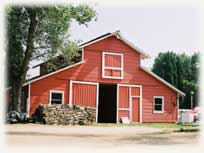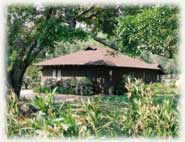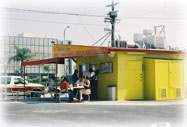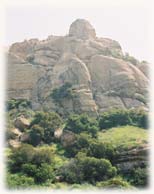| Members of the Chatsworth Chapter, NSDAR, have actively participated in the Chatsworth Historical Society (CHS) from its inception to identify national and local landmarks to preserve the history of our community.
The Pioneer Church, Los Angeles Cultural Historical
Monument No. 14, was built in 1903 with volunteer labor. The congregation served the
entire northwest San Fernando Valley until the 1950s when other churches were built.
Originally located at 10051 Topanga Canyon Boulevard,
it was scheduled to be demolished in 1963 when the Chatsworth Historical Society was
formed to save the building.
|
 |

|
In January 1965, the building was moved to the northwest corner of Oakwood Memorial Park,
22601 Lassen Street, Chatsworth, the first city monument to be moved. Roy Rogers and Dale
Evans Rogers were patrons of the CHS and assisted financially in the moving of the church.
It was refurbished and rededicated in 1976 as part of the community's Bicentennial Celebration.
On February 27, 1984, District VIII, California State Society, Daughters
of the American Revolution (CSSDAR), held a ceremony dedicating a historic marker for the building.
It can be viewed when the building is open for tours.

|
 |
Olive Trees on Lassen between Topanga Canyon Boulevard and Farralone Avenue was designated in 1967 as Los Angeles Historic-Cultural Monument #49 at the request of the Chatsworth Historical Society. The trees were planted by the Lassen Street property owner Nelson A. Gray in 1893. Native to the Eastern Mediterranean region, olive trees were introduced to California by Franciscan missionaries. In 1967 there were 76 olive trees; today there are 68 remaining.
|
| The Harvester Barn is Los Angeles Historic-Cultural
Monument number 64, and is located at 22049 Devonshire Street. Built
in the early 20th Century, this rural farm is now surrounded
by suburban housing, where the main farmhouse is a California Ranch
style structure with a basilica-type barn that can be seen down the
long flag driveway. This site was the headquarters of the Palomino Horse
Association of America and was Dan Hoffman's barn. "Harvester" was a
well-known Palomino stallion that stood at the ranch. He was the sire
of "Mr. Ed." Before Dan Huffman lived there, Edna Fagan
lived at the ranch when Harvester stood there. Dan had the barn named
a historic monument. The Harvester Barn (not the entire farm) is designated as a historic monument.
|
 |

|
The Homestead Acre is all that is left of what was once a 230-acre ranch.
It was settled in the spring of 1886 by James David and Rhoda Jane Hill.
Minnie Hill, the seventh of their eight children, was born on the property
in the fall of 1886. She later married Alfred Palmer and they lived on the
ranch raising their two children. Many of the beautiful trees, flowers, and
shrubs still growing today were planted by Minnie Hill Palmer and her family.
| The property is named to the National Register of Historic Places and is
Los Angeles Cultural-Historical Monument No. 133. It is owned by the Los
Angeles City Department of Recreation and Parks, with the Chatsworth Historical
Society as conservators.
|
 |

|
The Stage Coach Trail (Cultural-Historic Monument
Number 92) is a scenic hike along the historic Santa Susana Stage Road. Originally
a trail was established by the Fernandeño, Tataviam, and Chumash Indian tribes, where
later it became the El Camino del Santa Susana y Simi trail over the Santa
Susana Pass and was the route that linked Los Angeles, Simi Valley, and Ventura
from 1861 to 1877. Sedimentary rock, scrub oak, and fragrant sagebrush open
to spectacular views of the City of Chatsworth and the San Fernando Valley.
Near the top is a marker placed in 1939 by the Native Daughters of the Golden
West commemorating the Old Santa Susana Stage Road.
| The Chatsworth Reservoir Kiln Site is also
known as the Chatsworth Calera Site. It is located southeast at Woolsey Canyon
Road and Valley Circle Boulevard. This is the site where bricks and tiles were
made for the San Fernando Mission. There is a plaque for the Lime Kiln designating it as Los Angeles Cultural-Historic Monument 141.
|
 |

|

|
 |
The Munch Box is Los Angeles Cultural-Historic Monument number 750 and literally a "taste of the past." This
is a historic hamburger stand built around 1956. Still in operation,
it offers outdoor seating and is known for its hamburgers, fries, chili dogs,
and root beer. Located at 21532 Devonshire Street, the building has a unique
"space-age" facade of straight-lines, yellow stucco, and red trim.
|
| Stoney Point has been a landmark since
prehistoric times, guiding Native Americans through the later-named Santa Susana
Pass. Many Indian relics have been found nearby. The site is a popular location
for movie and television companies.
It is Los Angeles Cultural-Historic Monument No. 132 and is a 76-acre park owned
by the Los Angeles City Department of Recreation and Parks.
It is best known for its scenic beauty. Mountaineering enthusiasts
travel far and wide to experience climbing and rappelling strategies
amongst towering and spectacular rock formations. There are also small
caves for exploration, trails for hiking, and vistas for photo opportunities.
|
 |

|